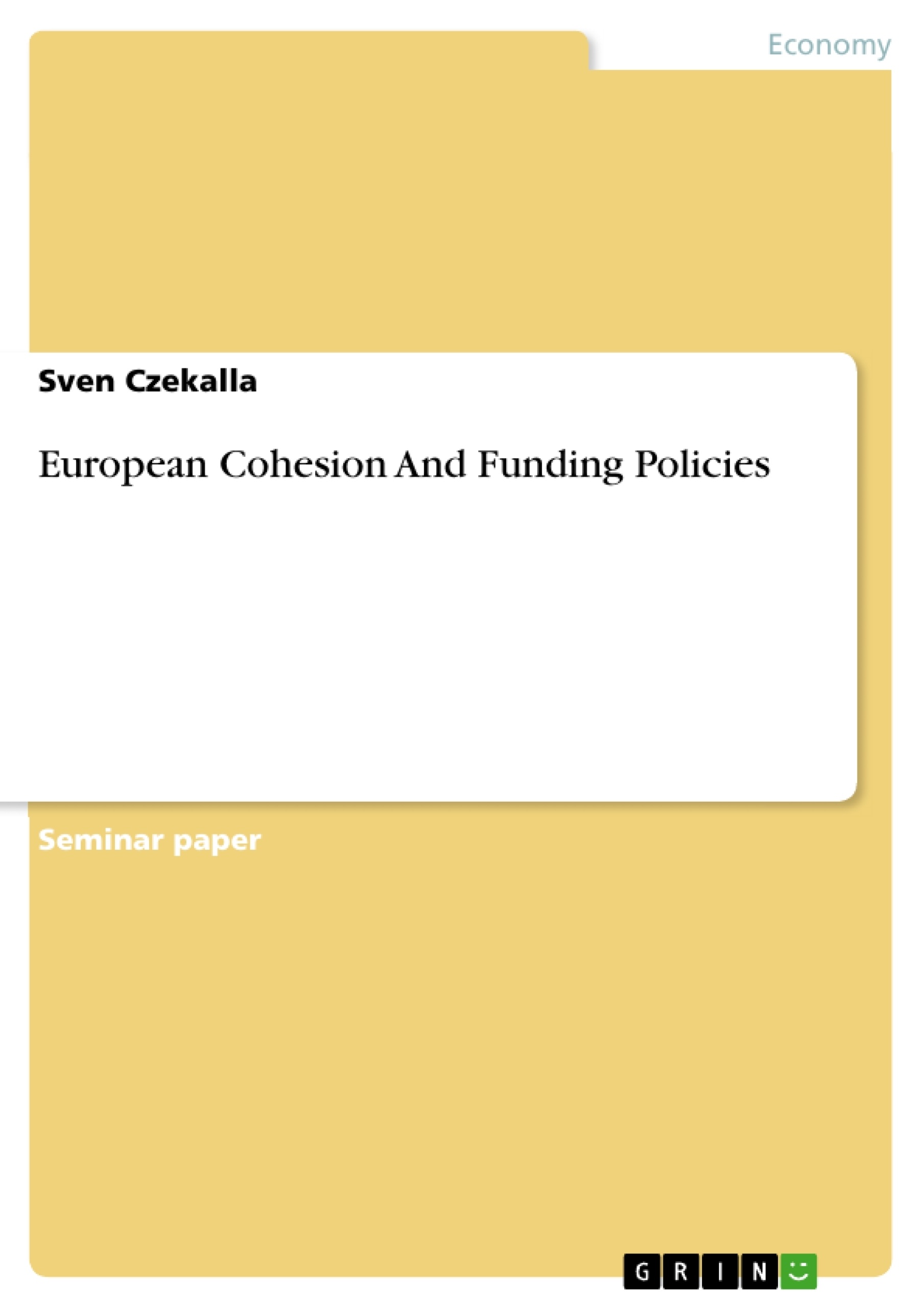The first chapter is divided into two sections; the first section aims to present the
most important steps toward the current systems of European Cohesion and Funding Policies,
and the second section summarizes the main funding streams of the current cohesion
policy. In addition, in the second part, the linkage between the different financial instruments
and the objectives of Structural Fund assistance is clarified.
The second chapter examines the effectiveness and efficiency of the cohesion policy in reducing
regional disparities, with a reference to the preceding funding period. Due to the
restriction on the length of in this paper, the reduction of regional disparities will be assessed
by examining economic performance and employment according to the objectives
of the cohesion policy and its financial instruments.
Due to the difficulties in separating the contributions of the cohesion policy from the
overall effects of progress, the achievements of the Lisbon objectives will be scrutinized in
the following section. Selected Structural Indicators will be examined to remark
on the progress in the set key areas.
The following section aims to conduct a partial examination of the impact and weaknesses of
pre-accession assistance. Examining the question of institutional and administrative capacity
building, the section will scrutinize the development of economic performance of
and employment levels in the new Member States in the 2000–2006 funding period.
The objective of the preceeding chapter is to determine the impacts of the Europe 2020 objectives
on cohesion policy, examine the adequacy of established goals, and compare the
Europe 2020 objectives with those of the Lisbon Strategy.
The objective of the last section is to analyze the proposals for a reformed cohesion
policy as submitted in the BARCA report. Therefore, the advantages and disadvantages
that appears when considering the proposals will be discussed. In addition, the main differences
with the current practice will be considered.
Inhaltsverzeichnis (Table of Contents)
- I. EUROPEAN COHESION POLICY
- A. ESTABLISHMENT, DEVELOPMENT, AND THE CURRENT STATUS OF THE COHESION POLICY
- B. FUNDING STREAMS AND THEIR OBJECTIVES
- II. LESSONS LEARNED - EXPERIENCES OF THE PAST FUNDING PERIOD
- A. EFFICIENCY AND EFFECTIVENESS
- B. COHESION POLICY AND THE GOALS OF LISBON
- C. OBJECTIVE INTEGRATION - THE MEMBER STATES OF THE EASTWARD ENLARGEMENTS
- III. NEW CHALLENGES, NEW WAYS? THE FUTURE OF THE COHESION POLICY
- A. IMPACTS AND ADEQUACY: EUROPE 2020
- B. THE BARCA-REPORT - MEASURE OF THINGS?
Zielsetzung und Themenschwerpunkte (Objectives and Key Themes)
This seminar paper delves into the European Cohesion Policy, examining its development, current status, and future prospects. It analyzes the efficiency and effectiveness of past funding periods, focusing on the relationship between cohesion policy and the goals of Lisbon. The paper also investigates the impact of eastward enlargements on objective integration and the challenges posed by Europe 2020.
- Development and current status of the European Cohesion Policy
- Evaluation of the effectiveness and efficiency of past funding periods
- Integration of cohesion policy with the goals of Lisbon
- Impacts of eastward enlargements on objective integration
- Challenges and opportunities for the future of the cohesion policy
Zusammenfassung der Kapitel (Chapter Summaries)
- Chapter I: EUROPEAN COHESION POLICY
- Section A: ESTABLISHMENT, DEVELOPMENT, AND THE CURRENT STATUS OF THE COHESION POLICY: This section traces the origins of the European Cohesion Policy back to the European Economic Communities (EEC) and its objectives of fostering economic development across member states. It highlights key milestones, including the establishment of the European Social Fund (ESF), the European Investment Bank (EIB), and the European Regional Development Fund (ERDF).
- Section B: FUNDING STREAMS AND THEIR OBJECTIVES: This section provides an overview of the main funding streams within the current cohesion policy, clarifying their linkages to the objectives of Structural Fund assistance.
- Chapter II: LESSONS LEARNED - EXPERIENCES OF THE PAST FUNDING PERIOD
- Section A: EFFICIENCY AND EFFECTIVENESS: This section examines the efficiency and effectiveness of past funding periods by comparing per capita GDP in PPS and employment rates for EU member states. It uses tables to illustrate the data and provide a clear analysis.
- Section B: COHESION POLICY AND THE GOALS OF LISBON: This section explores the alignment of cohesion policy with the broader objectives of the Lisbon Strategy, providing a critical analysis of the effectiveness of these policies in achieving their desired outcomes. The section utilizes tables to present relevant data and structural indicators.
- Section C: OBJECTIVE INTEGRATION - THE MEMBER STATES OF THE EASTWARD ENLARGEMENTS: This section analyzes the impact of eastward enlargements on objective integration, focusing on the effectiveness of cohesion policy in facilitating the integration of new member states from Eastern Europe.
- Chapter III: NEW CHALLENGES, NEW WAYS? THE FUTURE OF THE COHESION POLICY
- Section A: IMPACTS AND ADEQUACY: EUROPE 2020: This section examines the implications of Europe 2020 for the Cohesion Policy, highlighting the main goals and strategies of this initiative. It discusses the potential impact of these goals on the allocation and utilization of cohesion funding.
- Section B: THE BARCA-REPORT - MEASURE OF THINGS?: This section analyzes the recommendations of the Barca Report, a significant document that evaluated the effectiveness of the Cohesion Policy and proposed reforms to improve its performance. It explores the implications of these recommendations for the future of cohesion funding and its implementation.
Schlüsselwörter (Keywords)
The main focus of this paper lies on the European Cohesion Policy, covering its establishment, development, and current status. It examines funding streams, their objectives, and the policy's effectiveness in achieving its goals. Key themes include economic development, regional disparities, integration of new member states, efficiency, effectiveness, Lisbon Strategy, and Europe 2020. The paper also explores the implications of the Barca Report for future reforms and the overall direction of the Cohesion Policy.
- Quote paper
- Diplom-Betriebswirt (FH) Sven Czekalla (Author), 2010, European Cohesion And Funding Policies, Munich, GRIN Verlag, https://www.grin.com/document/173408



